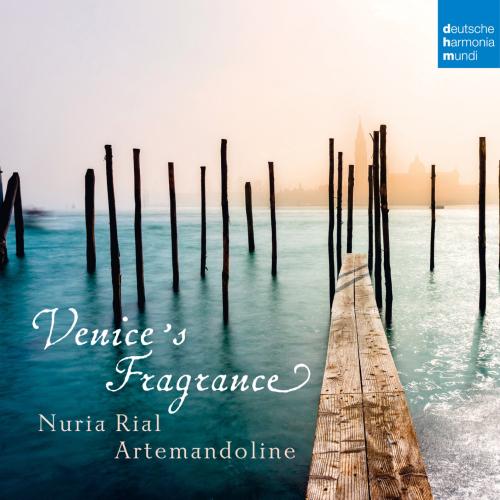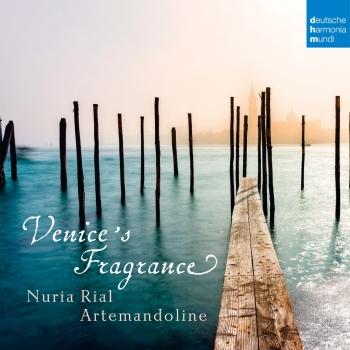
Venice's Fragrance Nuria Rial & Artemandoline
Album info
Album-Release:
2020
HRA-Release:
12.06.2020
Label: deutsche harmonia mundi
Genre: Classical
Subgenre: Vocal
Artist: Nuria Rial & Artemandoline
Composer: Antonio Vivaldi (1678-1741), Tommaso Traetta (1727-1779), Baldassare Galuppi (1706-1785), Gennaro Manna (1715-1779), Francesco Bartolomeo Conti (1681-1732), Carlo Arrigoni (1697-1744), Antonio Lotti (1666-1740)
Album including Album cover Booklet (PDF)
I`m sorry!
Dear HIGHRESAUDIO Visitor,
due to territorial constraints and also different releases dates in each country you currently can`t purchase this album. We are updating our release dates twice a week. So, please feel free to check from time-to-time, if the album is available for your country.
We suggest, that you bookmark the album and use our Short List function.
Thank you for your understanding and patience.
Yours sincerely, HIGHRESAUDIO
- Tommaso Traetta (1727 - 1779):
- 1 Le Feste d'Imeneo: Bella armonia vieni (Aria) 04:38
- Antonio Vivaldi (1678 - 1741): Concerto for two Mandolins in G Major, RV 532, F.5/2:
- 2 Concerto for two Mandolins in G Major, RV 532, F.5/2: I. Allegro 03:30
- 3 Concerto for two Mandolins in G Major, RV 532, F.5/2: II. Andante 02:58
- 4 Concerto for two Mandolins in G Major, RV 532, F.5/2: III. Allegro 03:19
- Baldassare Galuppi (1706 - 1785):
- 5 Jahel: Rosa e Lilio (Aria) 08:21
- Gennaro Manna (1715 - 1779):
- 6 Achille in Sciro: Se un core annodi (Aria) 03:15
- Francesco Bartolomeo Conti (1681 - 1732):
- 7 Il trionfo dell'amicizia e dell'amore: Dei colli nostri (Aria) 05:44
- Carlo Arrigoni (1697 - 1744): Sonata for Violin, Mandolin and Basso in E Minor:
- 8 Sonata for Violin, Mandolin and Basso in E Minor: I. Preludio - Presto 01:09
- 9 Sonata for Violin, Mandolin and Basso in E Minor: II. Canzona 02:35
- 10 Sonata for Violin, Mandolin and Basso in E Minor: III. Courante 02:28
- 11 Sonata for Violin, Mandolin and Basso in E Minor: IV. Presto 01:26
- Francesco Bartolomeo Conti:
- 12 L'Astarto: Finché spera che le rieda (Aria) 04:08
- Antonio Lotti (1667 - 1740):
- 13 Teofane: Lascia che nel suo viso (Aria) 07:13
- Anonymous:
- 14 Folias 08:56
- Antonio Vivaldi: Mandolin Concerto in C Major, RV 425 ; P.134 ; F.V.1:
- 15 Mandolin Concerto in C Major, RV 425 ; P.134 ; F.V.1: I. Allegro 02:37
- 16 Mandolin Concerto in C Major, RV 425 ; P.134 ; F.V.1: II. Largo 04:24
- 17 Mandolin Concerto in C Major, RV 425 ; P.134 ; F.V.1: III. Allegro 01:56
Info for Venice's Fragrance
Bereits das erste gemeinsame Album der katalanischen Sopranistin Nuria Rial mit dem in Luxemburg beheimateten Ensemble Artemandoline erhielt fantastische Besprechungen: »Das ist weit mehr als nur das Ständchen, das der Angebeteten als Bühnenmusik dargeboten wird. Da gibt es auch überaus virtuose Exemplare, in denen der Mandoline als obligatem Instrument alles abverlangt wird (...) Perfekt ergänzen die Streicher und Nuria Rial das Zupfinstrument in seiner Artikulation.« (Concerti) »Arien in Verbindung mit Mandolinen-Musik; eine schöne, originelle Idee, die thematisch durchaus über ein ganzes Album trägt. [...] Nuria Rial bleibt sich treu. [...] Die frische, mädchenhafte Stimme unverändert attraktiv.« (rbb Kulturradio)
Auf ihrem neuen Album präsentieren Nuria Rial und Artemandoline unter der Leitung von Juan Carlos Muñoz »musikalische Köstlichkeiten« (Toccata) diesmal vom Venedig des 18. Jahrhunderts. Alle Arien auf dem Album sind Weltersteinspielungen. Im Venedig des 18. Jahrhunderts entwickelte sich das Spiel auf der Mandoline zu höchster Perfektion und erklang als fester Bestandteil eines barocken Ensembles in Opern, Oratorien und Kantaten. Zwischen 1690 und 1799 sind etwa 200 Arien mit Mandoline entstanden. »Venice's Fragrance« erweckt diese wertvollen Arien für Sopran, Mandolinen und Streichinstrumente zu neuem Leben.
Ausgewählt wurden Arien aus Opern und Oratorien von in Venedig wirkenden Komponisten: Baldassare Galuppi (1706-1785), Francesco Bartolomeo Conti (1681-1732), Gennaro Manna (1715-1779), Tommaso Traetta (1727-1779) und Antonio Lotti (1667-1740). Hinzu kommen auch zwei Mandolinenkonzerte von Antonio Vivaldi (1678-1741) sowie eine Sonata für Mandoline und Violine von Carlo Arrigoni (1697-1744). Die Einspielungen bezaubern mit ihrem Einfallsreichtum, Raffinement und vor allem mit ihren einnehmenden Melodien - »welche uns hier von einer brillanten Sängerin und einem inspiriert und mitreißend agierenden Orchester vorgestellt werden.« (Toccata)
Nuria Rial, Sopran
Artemandoline:
Juan Carlos Muñoz, Baroque Mandoline
Mari Fe Pavón, Baroque Mandoline
Nuria Rial
studierte Gesang und Klavier in ihrem Heimatland Katalonien. Sie wechselte nach Basel in die Klasse von Kurt Widmer, machte 2003 ihren Abschluss und gewann den Helvetia Patria Jeunesse in Luzern für ihre herausragenden Fähigkeiten als Sängerin.
Ihre feine, klare Stimme, das weich schwingende Timbre, Musikalität und Ausdrucksstärke, öffneten ihr auf internationaler Ebene rasch die Türen. Als Konzertsängerin arbeitet sie mit Dirigenten wie Sir John Eliot Gardiner, Paul Goodwin, Trevor Pinnock, Teodor Currentzis, Gustav Leonhardt, René Jacobs, Thomas Hengelbrock und Laurence Cummings. Dabei wird sie von Spitzenensembles wie Concerto Köln, The English Concert, Kammerorchester Basel, Collegium 1704, Il Giardino armonico, Les Musiciens du Louvre, Elbipolis Barockorchester, La Cetra Basel und L‘Arpeggiata begleitet.
Neben ihrer Konzerttätigkeit ist Nuria Rial auch immer wieder auf der Opernbühne zu erleben, wie in Monteverdis „Orfeo“ unter der Leitung von René Jacobs an der Staatsoper Unter den Linden in Berlin und in Cavallis „Eliogabalo“ in Brüssel. Wichtige Mozartpartien auf der Bühne waren Pamina in Genua und Ilia auf einer Tournee durch die Schweiz. Nuria Rial hat sich viel mit Barockmusik und historischer Aufführungspraxis beschäftigt und hat sich so einen Namen gemacht. Parallel dazu interessiert sie sich aber auch für andere Musikrichtungen. 2012 überzeugte sie zum Beispiel in der Rolle der Nuria in der zeitgenössischen Oper „Ainadamar“ von Golijov am Teatro Real Madrid, Regie Peter Sellars. 2015 wird sie mit dem Budapest Festival Orchestra unter der Leitung von Ivan Fischer erneut die Pamina singen.
Als begeisterte Kammermusikerin pflegt Nuria Rial Partnerschaften mit Ensembles wie „il pomo d‘oro“, „Café Zimmermann“ oder dem "Nash Ensemble“. In ihren Liederabendprogrammen singt sie französisches und spanisches Repertoire, aber vermehrt auch das deutsche Lied.
Nuria Rial hat zahlreiche CDs für verschiedene Labels aufgenommen. Darunter die bekannte Figaro-Aufnahme mit René Jacobs. Seit Januar 2009 ist sie Exklusivkünstlerin bei Sony Classical/BMG Masterworks. Unter den letzten Aufnahmen waren ‚Traces to Anna Magdalena Bach‘ und Opernarien von Telemann, jeweils mit dem Kammerorchester Basel, "Duetti amorosi" mit dem Countertenor Lawrence Zazzo und Händels "Neun Deutsche Arien" mit der Austrian Baroque Company. Ihre CD „Ave Maria“ gewann den holländischen Edison Award.
Und preiswürdig ist sie bis heute geblieben. Im Jahr 2009 erhielt sie den beliebten Echo-Klassik-Preis gleich in zwei Kategorien. Zum einen war sie Nachwuchssängerin des Jahres mit dem Album „Haydn-Arie per un amante“ (L’Orfeo Barockorchester), und zum anderen wurde die CD „Teatro d’Amore“ mit Philipp Jaroussky (L'Arpeggiata) gekürt. 2010 folgte der Echo Klassik für die CD „Via Crucis“ mit Christina Pluhars „L’Arpeggiata“ und 2012 wurde Nuria Rial für ihre CD „Telemann“ mit dem Kammerorchester Basel in der Kategorie "Beste Opernarien CD" ein weiterer Echo verliehen.
Artemandoline
With their ensemble Artemandoline, formed in 2001, Juan Carlos Muñoz and Mari Fe Pavón chose to go back to the original documents in order to the establish the true pedigree of this incomparable family of instruments. They have made a major contribution to launching a movement to encourage musical freshness and rigour. A better understanding of the compositions, closer study of the early treatises, the playing styles, the musical environment of the glorious era of the mandolin, leads to better appreciation of Baroque music, which itself became over time a mode of thought and action.
Searching for early mandolins, working on the manuscripts, hunting down early treatises, exploring the iconography: these are the means by which, for more than ten years now, the musicians of Artemandoline have sought to do fuller justice to the works of Scarlatti, Vivaldi, Weiss, and their contemporaries. The success of this approach based on a return to the sources, which constitutes the most important development in the history of the interpretation of ‘serious’ music in the course of the twentieth century, has been made possible by the cooperation of many protagonists – musicians, but also concert organisers, recording producers, publishers, musicologists, and instrument makers.
To ensure that music composed in the past does not sound like mere ‘early music’ in the present, the performers must manage to be sufficiently free, spontaneous, anticipative and astonished in their intimate act of creation and the newness it engenders. Juan Carlos Muñoz and Mari Fe Pavón spend their lives searching out and reviving forgotten masterpieces of the mandolin repertory. They are not content with simply presenting their finds like ‘musical archaeologists’, but endeavour to transmit them to the wider public by means of the essential act of communication between interpreters, composers, and listeners.
Very quickly awarded prizes by the critics and enthusiastically acclaimed by the public, Artemandoline’s performances always create new impulsions in the development of both the perception and the interpretation of the works of the seventeenth and eighteenth centuries. Its musicians dedicate their time and their talents to the revival of the mandolin on the musical scene, participating in the current expansion of interest in it all over the world through their conservatory teaching and masterclasses, their concerts, and their publications. Artemandoline is one of the pioneers in this domain, in which it has forged an international reputation.
In a few short years, the ensemble has found its style, proved its instrumental quality, and thereby constituted a veritable identity. Soon after its formation, it took its place among the foremost ensembles in the realm of historical performance practice on plucked strings. Audiences and critics alike were immediately filled with enthusiasm for its lively musical style.
The musicians who make up the ensemble play on period instruments: Baroque mandolins, Renaissance and Baroque guitar, Baroque mandola and mandolone, Renaissance lute, treble lutes, mandolins from Brescia and Cremona.
They are regularly invited to appear at early music festivals in France and abroad, including the Festival de Musique Ancienne du Marais, Festival du Périgord Vert, the « Tage Alter Musik Regensburg » in Germany ; « Early Music Day Alden-Biesen (Belgique) », Musique en Catalogne romane, Festival de l’Épine in France; Monza e Brianza, Gaudete Early Festival (Piedmont), and Castello Reale di Sarre (Aosta), all in Italy; Narol and Wroclaw in Poland; the Baroque Days at the Philharmonie in Luxembourg;; the Bach Chamber Days in Riga (Latvia); Festival Musique d’Ensemble à Pommiers, Oissery, Sedan, and other engagements in Spain, Japan, Switzerland, and Algeria.
The ensemble Artemandoline is in residence at the Romanesque church of Mont St Martin (Longwy, Meurthe-et-Moselle, France).
Booklet for Venice's Fragrance













